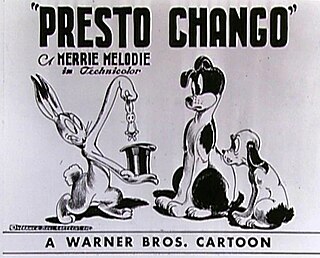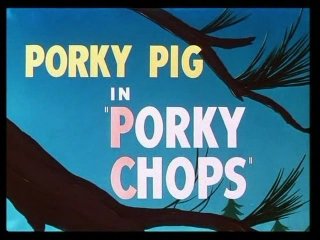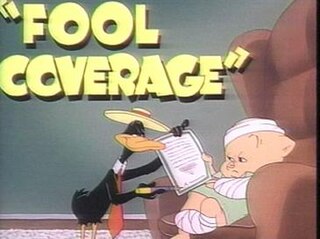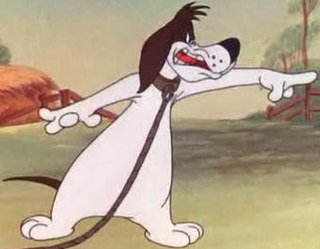Related Research Articles

Porky Pig is an animated character in the Warner Bros. Looney Tunes and Merrie Melodies series of cartoons. He was the first character created by the studio to draw audiences based on his star power, and the animators created many critically acclaimed shorts featuring the character. Even after he was supplanted by later characters, Porky continued to be popular with moviegoers and, more importantly, the Warners directors, who recast him in numerous everyman and sidekick roles.

Porky in Wackyland is a 1938 Warner Bros. Looney Tunes animated short film, directed by Bob Clampett. The short was released on September 24, 1938, and stars Porky Pig venturing out to find the last do-do bird, which he finds in Wackyland, a land that makes no sense located in Darkest Africa.

Petunia Pig is an animated cartoon character in the Looney Tunes and Merrie Melodies series of cartoons from Warner Bros. She looks much like her significant other, Porky Pig, except that she wears a dress and has pigtailed black hair.

Robin Hood Daffy is a 1958 Warner Bros. Merrie Melodies cartoon, directed by Chuck Jones and written by Michael Maltese. The short was released on March 8, 1958, and stars Daffy Duck as Robin Hood and Porky Pig as Friar Tuck.

Porky's Hare Hunt is a 1938 Warner Bros. Looney Tunes animated short film directed by Ben "Bugs" Hardaway and an uncredited Cal Dalton, which stars Porky Pig as a hunter whose quarry is a little white rabbit. The short was released on April 30, 1938.

Prest-O Change-O is a 1939 Merrie Melodies cartoon directed by Chuck Jones, and first released on March 25, 1939, by Warner Bros. It is the second appearance of Bugs Bunny as a manic white hare who made his first appearance in Porky's Hare Hunt, a cartoon that was produced and copyrighted in 1937 and released in April 1938, featuring him in the same early design. This is also the character's first appearance in a Merrie Melodies color film. The prototype of Bugs Bunny the screwy rabbit makes his third appearance in the next hare-based short film, Hare-um Scare-um (1939).

Awful Orphan is a 1949 Warner Bros. Merrie Melodies cartoon, directed by Chuck Jones and written by Michael Maltese. It is a sequel to the 1947 Looney Tunes short Little Orphan Airedale.

Porky Chops is a 1949 Warner Bros. Looney Tunes cartoon directed by Arthur Davis. The short was released on February 12, 1949, and stars Porky Pig.

A Corny Concerto is a 1943 Warner Bros. Merrie Melodies directed by Bob Clampett. The short was released on September 25, 1943, and stars Bugs Bunny, Porky Pig, Elmer Fudd and Daffy Duck.
Hook, Line and Stinker is a 1958 Warner Bros. Looney Tunes cartoon directed by Chuck Jones. The title is a pun on the idiom Hook, Line and Sinker. The short was released on October 11, 1958 with The Old Man and the Sea, and stars Wile E. Coyote and the Road Runner. When shown on Boomerang USA, this short plays in PAL audio.

Fool Coverage is a 1952 Warner Bros. Looney Tunes cartoon directed by Robert McKimson. The cartoon was released on December 13, 1952, and stars Daffy Duck and Porky Pig.

My Little Duckaroo is a 1954 Warner Bros. Merrie Melodies theatrical cartoon short directed by Chuck Jones and written by Michael Maltese. The cartoon was released on November 27, 1954 and stars Daffy Duck and Porky Pig.

This is a list of all cartoons featuring Porky Pig. Directors are listed in parentheses.
Daffy Doodles is a 1946 Warner Bros. Looney Tunes cartoon directed by Bob McKimson. It was released on April 6, 1946, and stars Daffy Duck and Porky Pig.
Wholly Smoke is a 1938 Warner Bros. Looney Tunes cartoon directed by Frank Tashlin. The short was released on August 27, 1938, and stars Porky Pig. This episode teaches about the dangers of smoking.

Barnyard Dawg is a Looney Tunes character. A feisty anthropomorphic basset hound, he is a friend and the archenemy of Foghorn Leghorn. He was created by Robert McKimson, who also created Foghorn, and was voiced by Mel Blanc. Dawg also feuds with other enemies as well like Henery Hawk, Daffy Duck and Sylvester. He appeared in 23 Golden Age–era Warner Bros. shorts.
The character that would evolve into Bugs Bunny appeared in four cartoon shorts before his first official appearance in Tex Avery's A Wild Hare. While this early version is commonly referred to as "Happy Rabbit", animation historian David Gerstein disputes this, saying that the only usage of the term was from Mel Blanc himself; the name "Bugs Bunny" was used as early as April 1938, from a model sheet made by Charles Thorson which was used for the short Hare-um Scare-um. Bugs was also mentioned by name from an August 1939 review of the short in the Motion Picture Herald.

A Bird in a Guilty Cage is a 1952 Looney Tunes animated short directed by Friz Freleng. The short was released on August 30, 1952, and stars Tweety and Sylvester. The title is a pun on the song "A Bird in a Gilded Cage".
Porky's Bear Facts is a 1941 Warner Bros. Looney Tunes cartoon animated short directed by Friz Freleng. The short was released on March 29, 1941, and stars Porky Pig. The voices were performed by Mel Blanc.
References
- ↑ Beck, Jerry; Friedwald, Will (1989). Looney Tunes and Merrie Melodies: A Complete Illustrated Guide to the Warner Bros. Cartoons. Henry Holt and Co. p. 123. ISBN 0-8050-0894-2.
- ↑ Lenburg, Jeff (1999). The Encyclopedia of Animated Cartoons. Checkmark Books. pp. 124–126. ISBN 0-8160-3831-7 . Retrieved 6 June 2020.